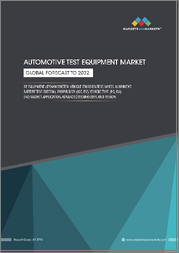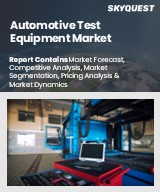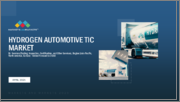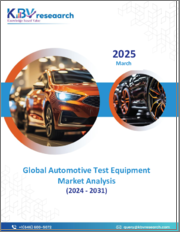
|
시장보고서
상품코드
1696984
세계의 자동차 시험 장비 시장 조사 보고서 : 산업 분석, 규모, 점유율, 성장, 동향, 예측(2025-2033년)Global Automotive Test Equipment Market Research Report- Industry Analysis, Size, Share, Growth, Trends and Forecast 2025 to 2033 |
||||||
세계의 자동차 시험 장비 시장 규모는 2024년 146억 8,000만 달러에서 2033년에는 202억 7,000만 달러로 성장하며, 2026-2033년의 예측 기간 중 3.65%의 견고한 연평균 성장률(CAGR)을 보일 것으로 예측됩니다.
자동차 기술의 급속한 발전과 자동차 시스템의 복잡성으로 인해 자동차 테스트 장비 시장은 큰 성장을 이룰 것입니다. 자동차 산업이 전기자동차(EV), 자율주행, 첨단운전자보조시스템(ADAS)으로 전환하면서 첨단 테스트 솔루션에 대한 수요가 급증하고 있습니다. 진단 툴, 배출가스 테스터, 성능 분석기를 포함한 자동차 테스트 장비는 엄격한 안전 및 환경 규제를 준수하기 위해 필수적입니다. 이 시장은 제조업체들이 엄격한 테스트 프로토콜을 통해 자동차의 성능, 신뢰성, 안전성을 향상시키기 위해 노력함에 따라 확대될 것으로 예측됩니다.
인공지능(AI)과 머신러닝(ML)과 같은 기술 혁신은 자동차 테스트 장비의 전망을 재구성하는 데 있으며, 매우 중요한 역할을 하고 있습니다. 이러한 기술은 예측 정비 및 실시간 데이터 분석을 통해 제조업체가 잠재적인 문제가 심각해지기 전에 미리 파악할 수 있도록 도와줍니다. 또한 자동차 테스트에 IoT를 통합하면 차량과 테스트 장비 간의 원활한 통신을 촉진하여 테스트의 정확성과 효율성을 높일 수 있습니다. 업계가 이러한 첨단 기술을 도입함에 따라 자동차 테스트 장비 시장은 테스트 프로세스를 간소화하는 스마트 커넥티드 솔루션에 대한 수요가 급증할 것으로 예측됩니다.
또한 지속가능성과 환경에 대한 책임에 대한 관심이 높아지면서 자동차 테스트 장비 시장에도 영향을 미치고 있습니다. 배출가스 저감 및 연비 개선에 대한 규제 압력이 증가함에 따라 자동차 제조업체들은 자동차 배출가스를 정확하게 측정하고 분석할 수 있는 첨단 테스트 솔루션에 투자하고 있습니다. 이 시장의 미래는 기술 혁신, 규제 대응, 지속가능성에 대한 약속의 결합으로 특징지어지며, 자동차 테스트 장비가 차세대 자동차 개발에 필수적인 요소로 남을 수 있도록 보장합니다.
당사의 보고서는 고객에게 다양한 산업 및 시장에 대한 종합적이고 실용적인 인사이트를 제공하기 위해 세심한 주의를 기울여 작성되었습니다. 각 보고서는 시장 상황을 완전히 이해하기 위해 몇 가지 중요한 요소를 포함하고 있습니다.
시장 개요 : 정의, 분류, 산업 현황 등 시장에 대한 자세한 서론.
시장 역학: 시장 성장에 영향을 미치는 주요 촉진요인, 억제요인, 기회 및 과제를 자세히 분석합니다. 이 섹션에서는 기술 발전, 규제 변화, 새로운 동향 등의 요인을 검토합니다.
세분화 분석 : 제품 유형, 용도, 최종사용자, 지역 등의 기준에 따라 시장을 명확한 부문으로 나눕니다. 이 분석을 통해 각 부문의 성과와 잠재력을 파악할 수 있습니다.
경쟁 구도: 시장 점유율, 제품 포트폴리오, 전략적 구상, 재무 실적 등 주요 시장 기업에 대한 종합적인 평가를 제공합니다. 주요 기업이 채택하고 있는 경쟁 역학 및 주요 전략에 대한 인사이트을 제공합니다.
시장 예측 : 실적 데이터와 현재 시장 상황을 바탕으로 일정 기간 중 시장 규모와 성장 추세를 예측합니다. 여기에는 정량적 분석과 미래 시장 궤적을 나타내는 그래프 표시가 포함됩니다.
지역 분석 : 지역별 시장 성과를 평가하고 주요 시장 및 지역 동향을 파악할 수 있습니다. 지역 시장 역학 및 비즈니스 기회를 이해하는 데 도움이 됩니다.
새로운 동향과 기회 : 현재 시장 동향과 새로운 시장 동향, 기술 혁신, 잠재적 투자 대상 분야를 파악합니다. 미래 시장 개발 및 성장 전망에 대한 인사이트를 제공합니다.
목차
제1장 서문
제2장 개요
- 시장의 하이라이트
- 세계 시장 스냅숏
제3장 자동차 시험 장비 업계 분석
- 서론 : 시장 역학
- 시장 성장 촉진요인
- 시장 성장 억제요인
- 시장 기회
- 업계 동향
- Porter's Five Forces 분석
- 시장의 매력 분석
제4장 밸류체인 분석
- 밸류체인 분석
- 원재료 분석
- 원재료 리스트
- 원재료 제조업체 리스트
- 주요 원재료의 가격 동향
- 잠재적 바이어 리스트
- 마케팅 채널
- 다이렉트 마케팅
- 인다이렉트 마케팅
- 마케팅 채널 발전 동향
제5장 세계의 자동차 시험 장비 시장 분석 : 제품별
- 제품별 개요
- 제품별 실적·예측 데이터 분석
- 섀시 다이나모미터
- 엔진 동력계
- 휠얼라이먼트 테스터
- 자동차 배기가스 시험 시스템
- 기타
제6장 세계의 자동차 시험 장비 시장 분석 : 장비 유형별
- 장비 유형별 개요
- 장비 유형별 실적·예측 데이터 분석
- 모바일/태블릿형 장비
- PC/랩톱 기반 장비
제7장 세계의 자동차 시험 장비 시장 분석 : 차종별
- 차종별 개요
- 차종별 실적·예측 데이터 분석
- 승용차
- 상용차
제8장 세계의 자동차 시험 장비 시장 분석 : 최종 용도별
- 최종 용도별 개요
- 최종 용도별 실적·예측 데이터 분석
- OEM
- 인정 서비스 센터
제9장 세계의 자동차 시험 장비 시장 분석 : 지역별
- 지역별 전망
- 서론
- 북미의 판매 분석
- 개요·실적·예측
- 북미 : 부문별
- 북미 : 국가별
- 미국
- 캐나다
- 멕시코
- 유럽의 판매 분석
- 개요·실적·예측
- 유럽 : 부문별
- 유럽 : 국가별
- 영국
- 프랑스
- 독일
- 이탈리아
- 러시아
- 기타 유럽
- 아시아태평양의 판매 분석
- 개요·실적·예측
- 아시아태평양 : 부문별
- 아시아태평양 : 국가별
- 중국
- 인도
- 일본
- 한국
- 호주
- 동남아시아
- 기타 아시아태평양
- 라틴아메리카의 판매 분석
- 개요·실적·예측
- 라틴아메리카 : 부문별
- 라틴아메리카 : 국가별
- 브라질
- 아르헨티나
- 페루
- 칠레
- 기타 라틴아메리카
- 중동 및 아프리카의 판매 분석
- 개요·실적·예측
- 중동 및 아프리카 : 부문별
- 중동 및 아프리카 : 국가별
- 사우디아라비아
- 아랍에미리트
- 이스라엘
- 남아프리카공화국
- 기타 중동 및 아프리카
제10장 자동차 시험 장비 기업의 경쟁 구도
- 자동차 시험 장비 시장의 경쟁
- 제휴·협력·협정
- 합병·인수
- 신제품 발매
- 기타 개발
제11장 기업 개요
- 상위 기업의 시장 점유율 분석
- 시장 집중도
- Continental AG
- Delphi Technologies
- ABB
- Robert Bosch GmbH
- Siemens
- Honeywell International Inc.
- Softing AG
- Denso Corporation
- ACTIA Group
- Vector Informatik GmbH
Global Automotive Test Equipment Market size is anticipated to grow from USD 14.68 Billion in 2024 to USD 20.27 Billion by 2033, showcasing a robust Compound Annual Growth Rate (CAGR) of 3.65% during the forecast period of 2026 to 2033.
The automotive test equipment market is poised for significant growth, driven by the rapid evolution of vehicle technology and the increasing complexity of automotive systems. As the automotive industry shifts towards electric vehicles (EVs), autonomous driving, and advanced driver-assistance systems (ADAS), the demand for sophisticated testing solutions is surging. Automotive test equipment, which includes diagnostic tools, emissions testers, and performance analyzers, is essential for ensuring compliance with stringent safety and environmental regulations. This market is expected to expand as manufacturers seek to enhance vehicle performance, reliability, and safety through rigorous testing protocols.
Technological advancements are reshaping the automotive test equipment landscape, with innovations such as artificial intelligence (AI) and machine learning (ML) playing a pivotal role. These technologies enable predictive maintenance and real-time data analysis, allowing manufacturers to identify potential issues before they escalate. Additionally, the integration of IoT in automotive testing facilitates seamless communication between vehicles and testing equipment, enhancing the accuracy and efficiency of tests. As the industry embraces these cutting-edge technologies, the automotive test equipment market is likely to witness a surge in demand for smart, connected solutions that streamline testing processes.
Furthermore, the growing emphasis on sustainability and environmental responsibility is influencing the automotive test equipment market. With increasing regulatory pressures to reduce emissions and improve fuel efficiency, manufacturers are investing in advanced testing solutions that can accurately measure and analyze vehicle emissions. The future of this market is characterized by a blend of innovation, regulatory compliance, and a commitment to sustainability, ensuring that automotive test equipment remains a critical component in the development of next-generation vehicles.
Our reports are meticulously crafted to provide clients with comprehensive and actionable insights into various industries and markets. Each report encompasses several critical components to ensure a thorough understanding of the market landscape:
Market Overview: A detailed introduction to the market, including definitions, classifications, and an overview of the industry's current state.
Market Dynamics: In-depth analysis of key drivers, restraints, opportunities, and challenges influencing market growth. This section examines factors such as technological advancements, regulatory changes, and emerging trends.
Segmentation Analysis: Breakdown of the market into distinct segments based on criteria like product type, application, end-user, and geography. This analysis highlights the performance and potential of each segment.
Competitive Landscape: Comprehensive assessment of major market players, including their market share, product portfolio, strategic initiatives, and financial performance. This section provides insights into the competitive dynamics and key strategies adopted by leading companies.
Market Forecast: Projections of market size and growth trends over a specified period, based on historical data and current market conditions. This includes quantitative analyses and graphical representations to illustrate future market trajectories.
Regional Analysis: Evaluation of market performance across different geographical regions, identifying key markets and regional trends. This helps in understanding regional market dynamics and opportunities.
Emerging Trends and Opportunities: Identification of current and emerging market trends, technological innovations, and potential areas for investment. This section offers insights into future market developments and growth prospects.
SEGMENTATION COVERED IN THE REPORT
By Product
- Chassis Dynamometer
- Engine Dynamometer
- Wheel Alignment Tester
- Vehicle Emission Test System
- Others
By Equipment Type
- Mobile/tablet-based Equipment
- PC/laptop-based Equipment
By Vehicle Type
- Passenger Cars
- Commercial Vehicles
By End-Use
- OEM
- Authorized Serviced Centers
- COMPANIES PROFILED
- Continental AG
- Delphi Technologies
- ABB
- Robert Bosch GmbH
- Siemens
- Honeywell International Inc.
- Softing AG
- Denso Corporation
- ACTIA Group
- Vector Informatik GmbH
- The above list can be customized.
TABLE OF CONTENTS
1. PREFACE
- 1.1. Report Description
- 1.1.1 Objective
- 1.1.2 Target Audience
- 1.1.3 Unique Selling Proposition (USP) & offerings
- 1.2. Research Scope
- 1.3. Research Methodology
- 1.3.1 Market Research Process
- 1.3.2 Market Research Methodology
2. EXECUTIVE SUMMARY
- 2.1. Highlights of Market
- 2.2. Global Market Snapshot
3. AUTOMOTIVE TEST EQUIPMENT INDUSTRY ANALYSIS
- 3.1. Introduction - Market Dynamics
- 3.2. Market Drivers
- 3.3. Market Restraints
- 3.4. Opportunities
- 3.5. Industry Trends
- 3.6. Porter's Five Force Analysis
- 3.7. Market Attractiveness Analysis
- 3.7.1 Market Attractiveness Analysis By Product
- 3.7.2 Market Attractiveness Analysis By Equipment Type
- 3.7.3 Market Attractiveness Analysis By Vehicle Type
- 3.7.4 Market Attractiveness Analysis By End-Use
- 3.7.5 Market Attractiveness Analysis By Region
4. VALUE CHAIN ANALYSIS
- 4.1. Value Chain Analysis
- 4.2. Raw Material Analysis
- 4.2.1 List of Raw Materials
- 4.2.2 Raw Material Manufactures List
- 4.2.3 Price Trend of Key Raw Materials
- 4.3. List of Potential Buyers
- 4.4. Marketing Channel
- 4.4.1 Direct Marketing
- 4.4.2 Indirect Marketing
- 4.4.3 Marketing Channel Development Trend
5. GLOBAL AUTOMOTIVE TEST EQUIPMENT MARKET ANALYSIS BY PRODUCT
- 5.1. Overview By Product
- 5.2. Historical and Forecast Data Analysis By Product
- 5.3. Chassis Dynamometer Historic and Forecast Sales By Regions
- 5.4. Engine Dynamometer Historic and Forecast Sales By Regions
- 5.5. Wheel Alignment Tester Historic and Forecast Sales By Regions
- 5.6. Vehicle Emission Test System Historic and Forecast Sales By Regions
- 5.7. Others Historic and Forecast Sales By Regions
6. GLOBAL AUTOMOTIVE TEST EQUIPMENT MARKET ANALYSIS BY EQUIPMENT TYPE
- 6.1. Overview By Equipment Type
- 6.2. Historical and Forecast Data Analysis By Equipment Type
- 6.3. Mobile/tablet-based Equipment Historic and Forecast Sales By Regions
- 6.4. PC/laptop-based Equipment Historic and Forecast Sales By Regions
7. GLOBAL AUTOMOTIVE TEST EQUIPMENT MARKET ANALYSIS BY VEHICLE TYPE
- 7.1. Overview By Vehicle Type
- 7.2. Historical and Forecast Data Analysis By Vehicle Type
- 7.3. Passenger Cars Historic and Forecast Sales By Regions
- 7.4. Commercial Vehicles Historic and Forecast Sales By Regions
8. GLOBAL AUTOMOTIVE TEST EQUIPMENT MARKET ANALYSIS BY END-USE
- 8.1. Overview By End-Use
- 8.2. Historical and Forecast Data Analysis By End-Use
- 8.3. OEM Historic and Forecast Sales By Regions
- 8.4. Authorized Serviced Centers Historic and Forecast Sales By Regions
9. GLOBAL AUTOMOTIVE TEST EQUIPMENT MARKET ANALYSIS BY GEOGRAPHY
- 9.1. Regional Outlook
- 9.2. Introduction
- 9.3. North America Sales Analysis
- 9.3.1 Overview, Historic and Forecast Data Sales Analysis
- 9.3.2 North America By Segment Sales Analysis
- 9.3.3 North America By Country Sales Analysis
- 9.3.4 United States Sales Analysis
- 9.3.5 Canada Sales Analysis
- 9.3.6 Mexico Sales Analysis
- 9.4. Europe Sales Analysis
- 9.4.1 Overview, Historic and Forecast Data Sales Analysis
- 9.4.2 Europe By Segment Sales Analysis
- 9.4.3 Europe By Country Sales Analysis
- 9.4.4 United Kingdom Sales Analysis
- 9.4.5 France Sales Analysis
- 9.4.6 Germany Sales Analysis
- 9.4.7 Italy Sales Analysis
- 9.4.8 Russia Sales Analysis
- 9.4.9 Rest Of Europe Sales Analysis
- 9.5. Asia Pacific Sales Analysis
- 9.5.1 Overview, Historic and Forecast Data Sales Analysis
- 9.5.2 Asia Pacific By Segment Sales Analysis
- 9.5.3 Asia Pacific By Country Sales Analysis
- 9.5.4 China Sales Analysis
- 9.5.5 India Sales Analysis
- 9.5.6 Japan Sales Analysis
- 9.5.7 South Korea Sales Analysis
- 9.5.8 Australia Sales Analysis
- 9.5.9 South East Asia Sales Analysis
- 9.5.10 Rest Of Asia Pacific Sales Analysis
- 9.6. Latin America Sales Analysis
- 9.6.1 Overview, Historic and Forecast Data Sales Analysis
- 9.6.2 Latin America By Segment Sales Analysis
- 9.6.3 Latin America By Country Sales Analysis
- 9.6.4 Brazil Sales Analysis
- 9.6.5 Argentina Sales Analysis
- 9.6.6 Peru Sales Analysis
- 9.6.7 Chile Sales Analysis
- 9.6.8 Rest of Latin America Sales Analysis
- 9.7. Middle East & Africa Sales Analysis
- 9.7.1 Overview, Historic and Forecast Data Sales Analysis
- 9.7.2 Middle East & Africa By Segment Sales Analysis
- 9.7.3 Middle East & Africa By Country Sales Analysis
- 9.7.4 Saudi Arabia Sales Analysis
- 9.7.5 UAE Sales Analysis
- 9.7.6 Israel Sales Analysis
- 9.7.7 South Africa Sales Analysis
- 9.7.8 Rest Of Middle East And Africa Sales Analysis
10. COMPETITIVE LANDSCAPE OF THE AUTOMOTIVE TEST EQUIPMENT COMPANIES
- 10.1. Automotive Test Equipment Market Competition
- 10.2. Partnership/Collaboration/Agreement
- 10.3. Merger And Acquisitions
- 10.4. New Product Launch
- 10.5. Other Developments
11. COMPANY PROFILES OF AUTOMOTIVE TEST EQUIPMENT INDUSTRY
- 11.1. Top Companies Market Share Analysis
- 11.2. Market Concentration Rate
- 11.3. Continental AG
- 11.3.1 Company Overview
- 11.3.2 Company Revenue
- 11.3.3 Products
- 11.3.4 Recent Developments
- 11.4. Delphi Technologies
- 11.4.1 Company Overview
- 11.4.2 Company Revenue
- 11.4.3 Products
- 11.4.4 Recent Developments
- 11.5. ABB
- 11.5.1 Company Overview
- 11.5.2 Company Revenue
- 11.5.3 Products
- 11.5.4 Recent Developments
- 11.6. Robert Bosch GmbH
- 11.6.1 Company Overview
- 11.6.2 Company Revenue
- 11.6.3 Products
- 11.6.4 Recent Developments
- 11.7. Siemens
- 11.7.1 Company Overview
- 11.7.2 Company Revenue
- 11.7.3 Products
- 11.7.4 Recent Developments
- 11.8. Honeywell International Inc.
- 11.8.1 Company Overview
- 11.8.2 Company Revenue
- 11.8.3 Products
- 11.8.4 Recent Developments
- 11.9. Softing AG
- 11.9.1 Company Overview
- 11.9.2 Company Revenue
- 11.9.3 Products
- 11.9.4 Recent Developments
- 11.10. Denso Corporation
- 11.10.1 Company Overview
- 11.10.2 Company Revenue
- 11.10.3 Products
- 11.10.4 Recent Developments
- 11.11. ACTIA Group
- 11.11.1 Company Overview
- 11.11.2 Company Revenue
- 11.11.3 Products
- 11.11.4 Recent Developments
- 11.12. Vector Informatik GmbH
- 11.12.1 Company Overview
- 11.12.2 Company Revenue
- 11.12.3 Products
- 11.12.4 Recent Developments



















